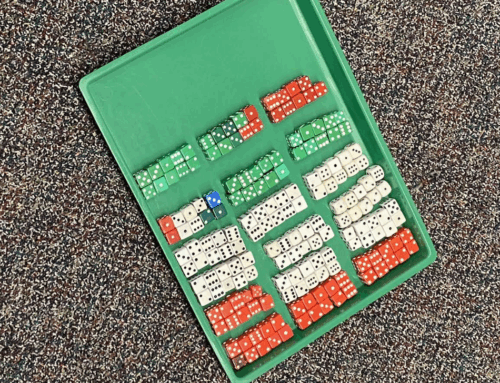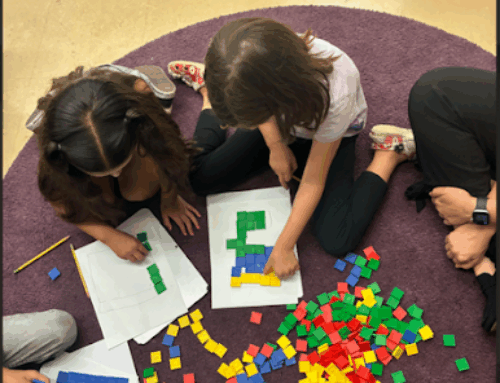Morning Meeting Online: Zooming with Second and Third Graders

Rusty Bresser
This week my friend and colleague Melissa Han invited me to Zoom with her second and third graders. When I logged on, her 24 students were just getting settled in, waiting for Melissa to finish inviting a few latecomers into the Zoom room. Some were still in their pajamas, others were sitting up attentively, while still others were finishing their breakfast. For teachers out there zooming with your class, this is a familiar sight.
 “Good morning!” Melissa says to her class in a welcoming voice. “Thumbs up if you got enough sleep last night?” Lots of thumbs go up, and a few thumbs go down. It’s obvious that some of her students just got out of bed.
“Good morning!” Melissa says to her class in a welcoming voice. “Thumbs up if you got enough sleep last night?” Lots of thumbs go up, and a few thumbs go down. It’s obvious that some of her students just got out of bed.
“Find a spot in your house that you can learn best,” Melissa says. “Our bodies help our brains to learn, so sit up straight.”
Melissa proceeds to let the children know what’s on the schedule for their morning meeting by reading the morning message on a shared screen. First there will be greetings, followed by a scavenger hunt, and then finally they’ll brainstorm together ways to problem solve when someone or something makes them feel bad. The primary goal of a morning meeting according to the Responsive Classroom is to give students a safe environment that provides a sense of trust, allows all students to feel important and that encourages respectful learning. Math games, routines, and activities can also be part of morning meetings.
Another purpose of a morning meeting is to practice respectful communication skills such as listening to others, taking turns, respectfully disagreeing, maintaining eye contact, and staying on topic. Having a dedicated time to practice these skills is essential in online environments where distractions at home can inhibit learning, especially for very young children.
Morning Meeting Greeting
One thing that struck me about this morning meeting was Melissa’s approach. Her voice is full of enthusiasm and positivity, her words are encouraging and reassuring, and she uses lots of reinforcing language to help students stay focused and engaged:
“I’m so proud of you for using the chat!”
“Hi Jaime! I’m so glad that you are here today!”
“I notice that most of you have your learning tools next to you.”
“I see that most of you are muted. This makes it easier to hear one another.”
“Yes, sometimes our audio isn’t working and that’s ok. Just use the chat.”
Melissa begins by asking the students, “If your morning was like an animal, what would it be?” She models for the class what animal her morning would be and explains why. Then she shares her screen revealing a sentence frame for the morning greeting:
Good morning _________. My morning is a _________ because ________.
Melissa facilitates the morning greeting telling each student who they are to greet and encourages them to use the frame. The students are hilarious. One student says, “My morning is a lion because they growl like me. I’m grumpy today.” Someone else reports that her morning is like a giraffe because she can see everything around her. A girl explains that her morning is an owl because she stayed up all night! Students’ mornings are like cats, birds, elephants, dogs, and so on. It’s obvious on everyone’s faces that they are enjoying this greeting. They’re also getting a chance to say something online and learn one another’s names.
Scavenger Hunt: A Way to Engage Students Online
One thing I notice is that five or six students’ cameras are off, so we can’t see their faces. But once Melissa begins the scavenger hunt, everyone’s cameras are on and ready to go.
Melissa begins the scavenger hunt by sharing her screen which shows a timer. She tells the class that they will have 10 seconds to find something in their house and safely bring it back and hold it up to their screen.
“Find something that is your favorite color. Go!” Melissa shouts.
By the time ten seconds are up, students are waving the things they’ve found. Melissa calls out, “I see pictures, a teddy bear, a pencil” and so on. The kids are engaged and excited. Melissa continues with a few more:
“Find something that is the shape of a rectangle.”
“Find something that is red.”
Breakout Room Conversations: Benefits and Challenges
After a stretch break, Melissa reminds her students about the conversations they’ve been having during the week’s morning meetings about finding peaceful places in their homes to do schoolwork, attend zoom meetings, and to just relax and settle down. She screen shares a slide with photos of peaceful places.

Melissa asks her students how they know when they are not feeling right. Then she sends them to breakout rooms to practice talking with a partner about what to do when someone makes them feel sad, teases them, or when their feelings are hurt. This time to practice taking turns and talking is important, especially when students are expected to engage in mathematical conversations during math class.
I join a breakout room and as soon as I start chatting with the two second graders, I immediately see the benefits and challenges of breakout rooms with kids. One of the second graders readily shares her ideas, while the boy seems shy and quiet. I’ve noticed that getting students to talk and share online is much harder than in face-to-face settings. Even with adults, it takes time and practice getting used to talking with someone when you are only looking at their face on screen. It can feel remote, and the effect can be isolating. Students need practice speaking on screen, especially at the beginning of the school year.
When Melissa visits the room, things turn around. She reminds the students of the topic at hand, provides an oral prompt to help them get started, and asks them a few questions that jumpstart the conversation. All of these actions help keep the two students on task, engaged, and accountable.
Math Ideas for Morning Meeting
While morning meetings are mostly used for building community, teachers can insert some quick math activities/routines that provide opportunities for students to practice their communication skills. Here are a few that are appropriate for morning meeting:
Splat Math
Talking Math
Guess My Number Routine
Mystery Number Routine
Final thoughts
I left the meeting excited, hopeful, and wanting to be a student in Melissa’s class! I think what impressed me the most was Melissa’s positive and encouraging attitude and voice. She made everyone feel safe, important, and respected, exactly what a morning meeting is designed to do. When students feel safe and have a trusting relationship with their teacher and classmates, they are better able to take intellectual risks when doing mathematics.
Every time I visit a Zoom meeting with kids, I’m reminded of how hard they are to facilitate. Teaching online can feel like you are flying blind; there are so many challenges! Students are sometimes hard to hear, reluctant to share their ideas, forget to mute and unmute at the right time, and some have their cameras off so we can’t see them. Getting the class to focus, pay attention, stay on task, and stay engaged can be a monumental challenge. And I haven’t even mentioned assessing their understanding!
But I remain hopeful, especially after visiting Melissa’s class. There are so many things that she does that make her lessons online successful. She elicits non-verbal responses (raise your hand, show me a thumbs up, wave at me if…., nod your head). She reinforces what she wants to see. Her breakout rooms are short, sweet, and purposeful. She provides movement breaks, shows videos, consistently calls students by their names, and models what she wants to see. Like I said, she makes me want to be in her virtual classroom. Fortunately, one of my student teachers will get the chance this fall.



